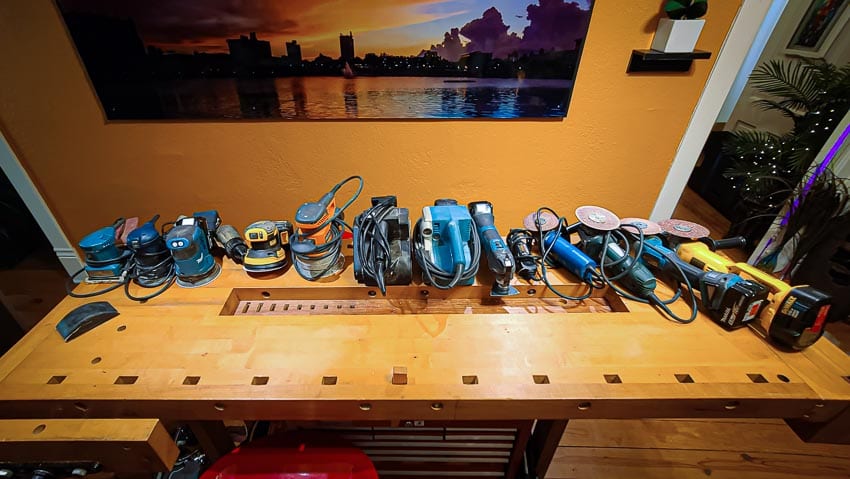I will give you this short answer first when asked about the different types of handheld sanders. Buy a random orbit sander and make it a good one. Then you can buy the other types of sanders as you need them. I have bought a lot of sanders over 30 years of woodworking.
Each one has its place and does a different task, but if I could only have one, it would be the random orbit sander. If I could only have two sanders, it would be one corded and one cordless random orbit sander. The others are for special cases. Buy those as you need them.
Table of Contents
Hand Sanding
We all love our power tools but, but don’t let hand sanding be forgotten as an option. My advanced wood technology teacher would let you use power sanders on your projects. However, when you were done, he would take a red pen and draw all over it and say “now hand sand it until you can’t see the red.” Sanders have gotten better in the thirty years since those days, but hand sanding is still a necessary skill, especially between coats of finish.
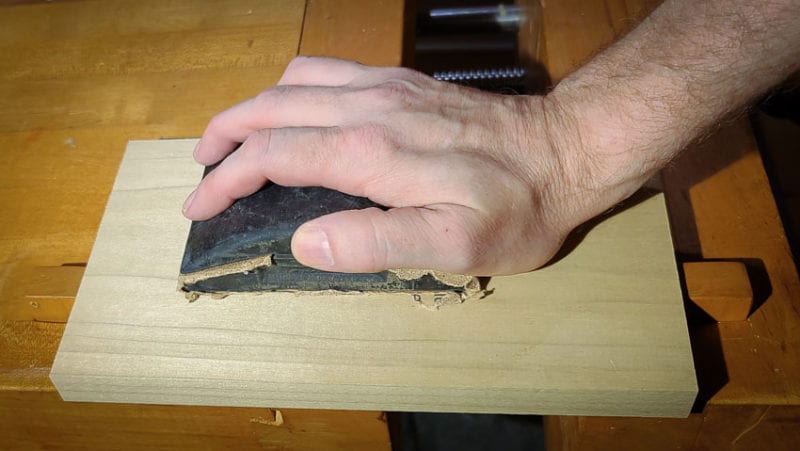
Palm Sanders
Palm sanders are also known as sheet sanders because they use 1/4 of a sheet of standard sandpaper. You used to be able to get sheet sanders in 1/2 sheet sizes, but I have not seen one of those in years except at garage sales. These small sanders work by vibrating, usually in small circles. They don’t work very well and have poor dust collection. The best reason to use one is as a punishment for your teenager staying out too late! They won’t do it again!
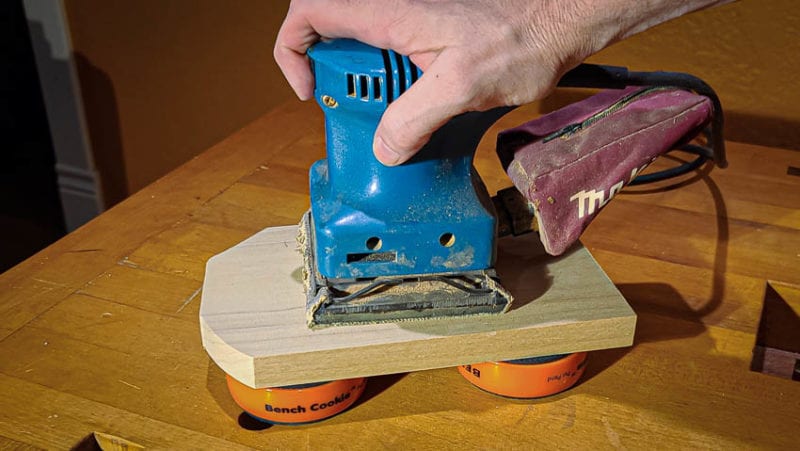
Detail Sanders
A detail sander, sometimes called a mouse sander, is a type of handheld sander that works just like the sheet sander only it has a triangular tip for getting into hard-to-reach places. They use Velcro backing and have more holes so the dust collection works much better than the sheet sander. They are not very effective for large areas and but they are great for getting into corners. At least they are inexpensive. Skil makes a good one, but if you have an oscillating multitool, you can use it instead.
Editor’s Note: Check out our best oscillating multi-tool reviews article.
Random Orbit Sanders
This is your go-to sander for most cases. Available in corded, cordless, and pneumatic (air), the random orbit sander is the most important type of handheld sander. They are great for all types of material from wood to metal to plastics. Arguably, they leave the best finish of any sander due to the randomness of the scratch pattern they make when sanding. With 60 grit paper, they are reasonably good at heavy stock removal. With 220 grit paper, they are especially good at fine sanding or sanding between coats of finish.
One tip though is to avoid the temptation to lift the sander up and sand from an edge instead of keeping the sander flat. It only seems like you are going faster. What you are actually doing is gouging your material. Most random orbit sanders come in 5-inch models but there are a few 6-inch models out there.
We don’t recommend buying the 6-inch model. We find it too difficult to locate the sandpaper for them since they are rare. Speaking of sandpaper, don’t buy the cheapest you can find. It pays to buy better paper. We have reviewed Diablo sanding disks and found them to be excellent.
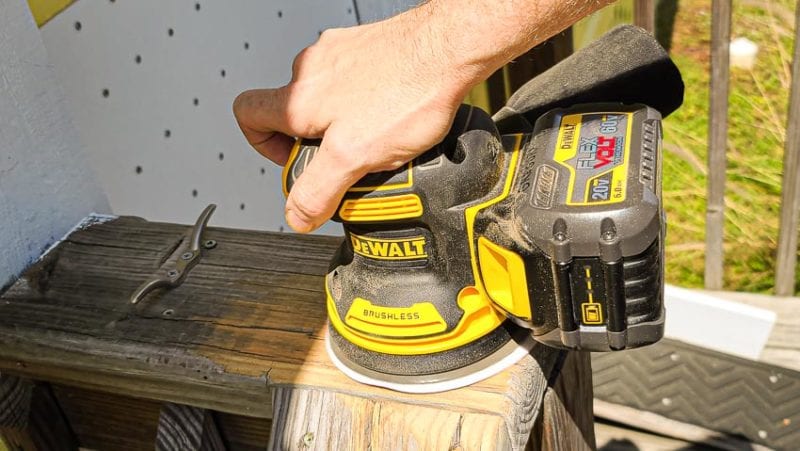
Belt Sanders
Of the different types of handheld sanders, the belt sander is good at heavy stock removal over a large surface. These can be used to flatten panels if you are not comfortable with hand planes. It is also good at paint removal over large areas with the right belt. They come in two common sizes of 3” x 21” belts and 4” x 24” belts. Considering what you are trying to do with one, in my opinion, you should buy the bigger 4” x 24” size. Forgo the smaller one unless you physically can’t handle them.
When you turn them on, they try and run away, so hang on! Always keep them moving because they remove material quickly. As soon as you stop moving, they start digging a gouge in your workpiece!
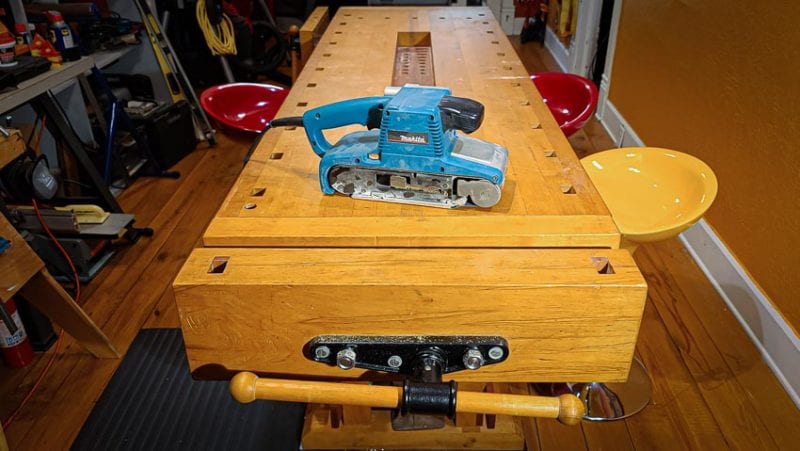
Mini Belt Sanders
When it comes to types of handheld sanders, there is a separate category of mini belt sanders, sometimes called wand or file sanders. These come in widths of 3/8”, 1/2”, 3/4”, 1”, and 1-1/8” and are available in either cordless, corded, or pneumatic. They are made for reaching into hard-to-reach areas and small details. These can be used to both smooth and shape small areas.
Inline Sanders
Inline sanders are normally found in automotive body shops to flatten large areas. This is strictly a pneumatic tool and it takes a large compressor to keep it running. They are used in woodworking applications to flatten large panels but a filter must be used to keep oil from spitting on your wood which will later ruin your finish. Inline sanders move in a straight line back and forth motion, just like you would hand sanding, except that they are 15” long and operate at 3000 strokes per minute.
A popular model is the Ingersoll Rand 315. Inline sanders typically require 6 cfm (cubic feet per minute) which is a lot more air than most air compressors can put out. So, before you buy one, make sure your compressor can handle it. If yours can, these sanders do a great job of flattening all materials. As a sculptor’s apprentice, I spent many hours using inline sanders to flatten aluminum plates that were welded together.
Angle Grinders
When it comes to types of handheld sanders, you might not think of an angle grinder as a sander, but if you buy a $15 4-1/2” backing pad, it turns your grinder into one of the fastest wood removal tools I know of next to a chain saw. If you use 24 or 36 grit paper, you can remove years of paint instantly. Just practice first so you don’t gouge the wood underneath. With 24 or 36 grit you can actually carve wood or round corners. Anything it touches disappears instantly. With 80 grit and some practice, you can smooth out rough wood or sand welds flat.
The sculptor I use to work for taught me to use a sanding disk instead of a grinding disk as we could grind welds down and flatten the surrounding area in one step. We would then use a random orbit sander or inline sander and you would never know there was a weld there when we put an automotive finish on the sculpture. Pneumatic grinders are used to sand stone because of the speed, power and resistance to dust. Eclectic grinders can do it, but the stone dust will kill them pretty fast.
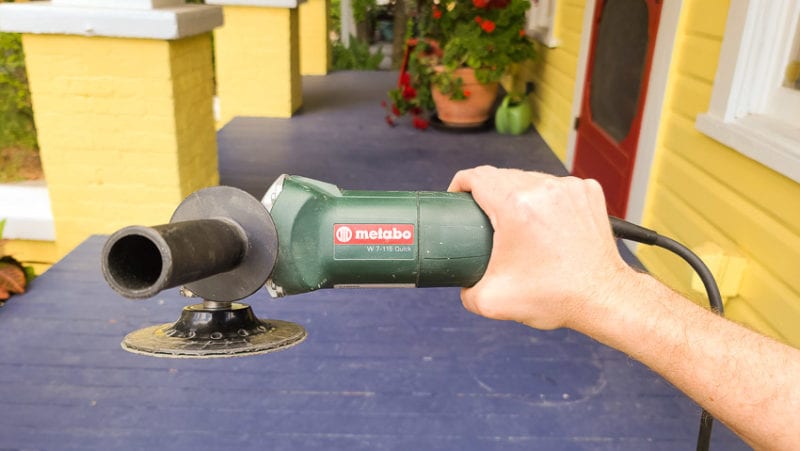
Oscillating Multitools
An oscillating multitool does many things, as the name suggests. It saws wood, metal, & plastic, removes grout, cuts holes in drywall. It also sands wood. One of the attachments that you can get for the multitool is a triangular head like the detail sander mentioned above. It is smaller, so it gets into smaller places. The head vibrates back and forth, sanding the wood, plastic, stone, or metal. The sandpaper is held on with velcro. It does not typically have dust collection. Here is our pick for the best oscillating multitools.
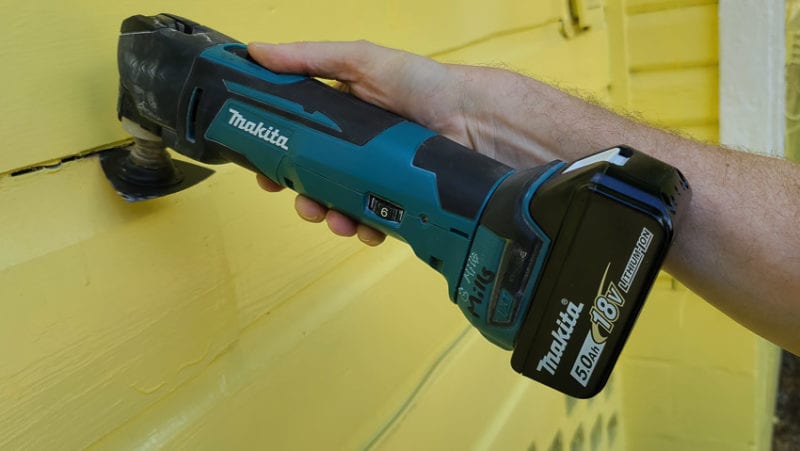
Rotary Tools (AKA a Dremel)
One of the last types of handheld sanders to talk about is the rotary tool, made popular by Dremel. The oscillating multitool does a good job of getting into small detail areas. However, they need to be flat or concave surfaces. Use the rotary tool on convex areas or extremely small areas. It can sand, grind and polish with its myriad of drum sanders, burs, and other bits.
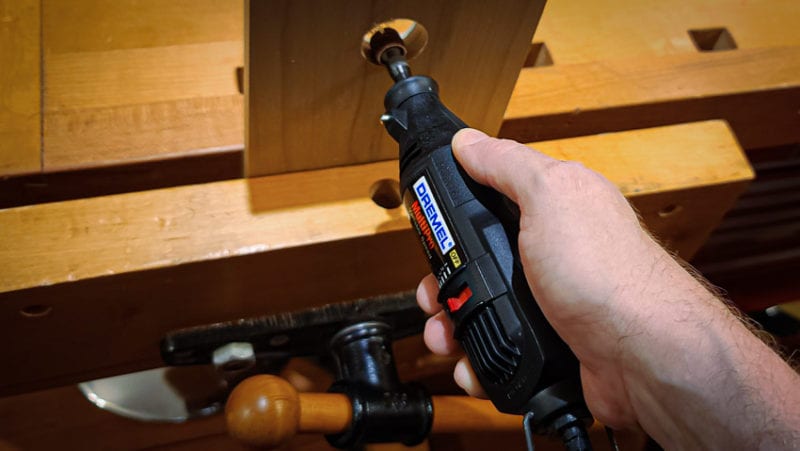
Drum Sanders
A handheld drum sander is a specialized tool used to shape wood or stone. While you can get them as electric or even an attachment for a drill, they are usually pneumatic tools with a handle on both ends like a rolling pin. In fact, they look like rolling pins of various sizes depending on you the size you get. Most require also purchasing a straight-inline pneumatic drill to operate, or at least to use well. You can use a regular drill, but the experience will be bad. They are great for doing things like shaping the convex parts of seats on wooden chairs by eye. Use a grinder with a sanding disk to shape the concave parts of the chair seat.
Disk Sanding Attachments for Drills
Are you kidding me! Don’t waste your money. I know they are only $10 but the Skill Detail sander is $25 and at least you have a real sander.
Types of Handheld Sanders: Conclusion
As you can see, there are quite a few different types of handheld sanders to choose from. The random orbit sander will do the best job. Whether you need a cordless and/or corded model depends on how hard you drive them at any given time. My next choices would be a grinder, belt sander, or oscillating multitool, depending on the type of work you do. The other tools on the list are specialized and not necessary unless they will solve a specific problem you run into.
amzn_assoc_placement = "adunit0"; amzn_assoc_search_bar = "false"; amzn_assoc_tracking_id = "protoorev-20"; amzn_assoc_ad_mode = "manual"; amzn_assoc_ad_type = "smart"; amzn_assoc_marketplace = "amazon"; amzn_assoc_region = "US"; amzn_assoc_title = ""; amzn_assoc_linkid = "4409ed9472421f68181f0f6248988be3"; amzn_assoc_asins = "B00OJWLNMO,B014QUP28E,B07KL4QGSQ,B00H6A7JA6,B01ER7J976";

